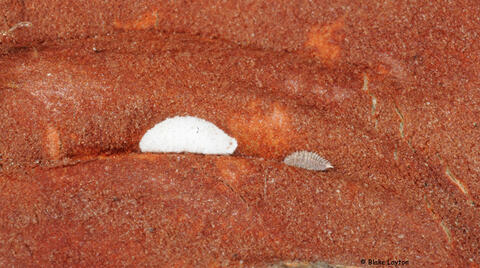Bug’s Eye View
Crape Myrtle Bark Scale Vol. 2, No. 9

Eriococcus lagerstroemia
Order: Hemiptera
Family: Eriococcidae
Crape myrtle bark scale (CMBS) is a serious new pest of crape myrtles in Mississippi. Trees that are heavily infested with this scale are unsightly and exhibit poor growth and bloom production. Trunks of heavily infested trees are usually black with sooty mold, and so is the mulch and any smaller plants growing underneath the tree. Trunks, large limbs, small limbs, and twigs are also covered with patches of off-white felt-like material that is composed of the bodies of adult scales. Felt covers of adult female scale are about 1/10 inch long (see photo, left). Nymphs, which are not covered with felt, vary in color, from off-white to grey to pink (see photo, above).
As of spring 2016, there are four areas of the state with confirmed infestations of CMBS: Ocean Springs, Madison, Oxford, and Olive Branch. If you detect this scale on crape myrtles in other areas of the state, please report your find to your local county extension office so they can relay the information to the Mississippi Department of Agriculture. The best defense against introducing CMBS into your landscape is to avoid buying and planting infested crape myrtles. Purchase plants from reputable nurseries that are aware of CMBS and work diligently to keep it out of their nursery. Inspect plants carefully before purchase.
Control: Systemic insecticides such as imidacloprid, dinotefuran, or thiamethoxam applied as soil injections or soil drenches in May to June are the best treatments available for crape myrtle bark scale. Because these treatments do not give 100% control, plan on treating trees again the following year—even if you don’t see any scale on them. See Extension publication 2938, Crape Myrtle Bark Scale Identification and Control, for more information. This publication contains tables with recommended insecticides for both home and commercial application, including brand names, treatment rates, and tips on how to use these soil-applied products.
Let others know about the Bug’s Eye View Newsletter: If you know someone who might enjoy receiving the Bug’s Eye View Newsletter, please share. They can easily subscribe by clicking on the sign up link shown below.
Blake Layton, Extension Entomology Specialist, Mississippi State University Extension Service.
The information given here is for educational purposes only. Always read and follow current label directions. Specific commercial products are mentioned as examples only and reference to specific products or trade names is made with the understanding that no discrimination is intended to other products that may also be suitable and appropriately labeled.